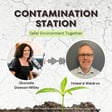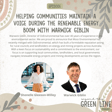
Contaminated Land as a Human Issue with James Maxwell
For the past three years, James Maxwell has served as Environment & Compliance Manager for Moree Plains Shire Council, a rural LGA in northwest NSW.
While James still considers himself to be relatively new to local government, he brings 10 years of environmental consultancy experience into the role, with a focus on development impact assessment, contaminated land management and asbestos assessment.
Since joining Moree Council, James has spearheaded the integrated management of a large and growing number of burnt, derelict and asbestos-containing properties within the Shire, working cross agency and with the community.
James joins us in this episode to share his direct experience, and a powerful perspective shift of viewing contaminated land as an issue at the community level, and not just as a 'problem to be solved'.
You'll hear insight into the impact a lack of technical expertise can have in rural areas, what it takes to deal with asbestos issues in dilapidated properties that have been left unmanaged, and why we must consider contaminated land, especially asbestos issues, as a human and community issue.
Thanks for listening! Be sure to rate, review and subscribe to the podcast, and stay tuned for the next episode of Contamination Station: Safer Environment Together.



















